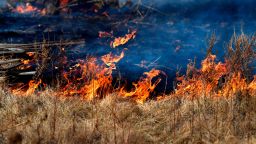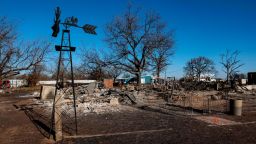Firefighters are making progress against a wildfire at Fort Hood that has scorched about 33,206 acres, according to the Texas A&M Forest Service.
The Crittenberg Complex fire in Coryell County, about 120 miles south of Fort Worth, is made up of three fires that have burned together.
It was 70% contained by Tuesday evening, according to the forest service. “Fire crews are mopping up and patrolling the fire area to check for hotspots,” it tweeted.
Officials earlier spelled the fire the Crittenburg Complex.
Fort Hood, a US Army post, said Monday that while extreme conditions continue, the fire currently poses no danger to any homes, structures or infrastructures. “No firefighters have been injured. Fire crews continue to cut fire breaks around the fire to minimize the fire’s ability to spread.”
Gov. Greg Abbott on Tuesday warned residents to stay vigilant as significant portions of the western half of the state face “extreme fire weather conditions” due to high wind gusts, dry fuels, and low humidity; and severe storms – with the potential for large hail, damaging winds, tornadoes, and flash flooding – possible.
“The State of Texas has been working closely with local officials to respond to dangerous conditions created by wildfires and is prepared respond to any emergencies that may arise with severe weather,” Abbott said in a news release, adding that there are 19 state agencies involved in the fire response.
Disaster declarations issued by the governor for 16 counties affected by wildfires, as well as the 16 counties impacted by tornadoes during last week’s severe storms, remain in place, the office said.
The state has been beleaguered by wildfires in the past few weeks. This month, 726 wildfires – 121 in the past seven days – have burned through 164,257 acres across the state, the forest service said in a news release Monday.
“Critically dry vegetation” is fueling the fires amid drought conditions, the agency said. Weather conditions could worsen the situation.
“There is potential for large wildfires to occur today that may outpace firefighters’ suppression efforts in areas near Childress, Lubbock, Abilene, Mineral Wells, Brownwood, Midland, San Angelo, Fredericksburg, Del Rio, Laredo and Brownsville,” the release read.
By Tuesday, according to the release, the potential for large wildfires will escalate as “critical fire weather” is expected to develop over a large area of the state west of the I-35 corridor.
The Crittenberg Complex blaze likely started with munitions fired in a Fort Hood training area, garrison commander Col. Chad Foster said at a news conference.
“All indicators point to small arms fire and some mortars that may have caused the fire on the installation,” he said.
It’s unusual for small arms to start fires, which generally are caused by bigger guns or tanks or artillery systems, Foster said, but “extreme drought conditions” led to “something that normally we probably wouldn’t have thought.”
Amanda Burson Latham was helping a friend move farm equipment Sunday near Fort Hood and came across the Crittenberg Complex fire, she said.
“The flames were 30-40 feet high and there was a mixture of black and rust colored smoke that covered the sun,” making everything an “eerie color,” Latham said.
“You could feel the heat of off it and hear the trees breaking and cracking and the fire roaring,” Latham said.
The Eastland Complex, a combination of seven fires, has burned more than 54,500 acres and is 90% contained, according to the interagency website Inciweb.
CNN’s Rebekah Riess and Raja Razek contributed to this report.






